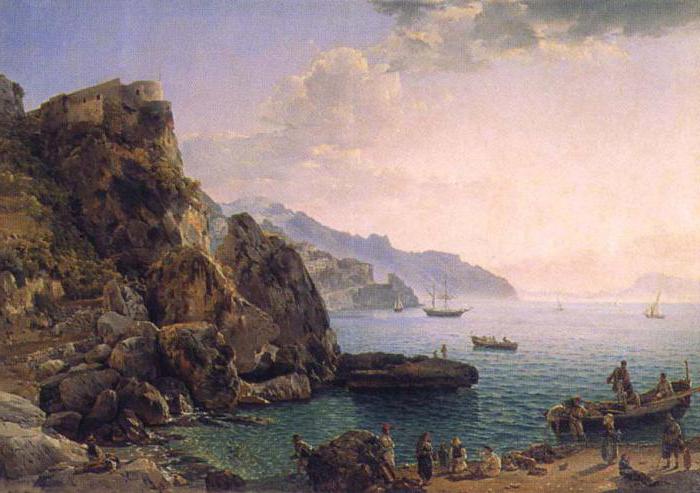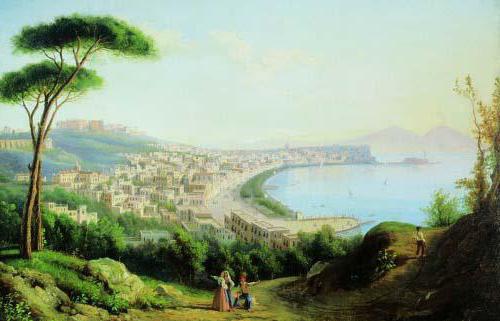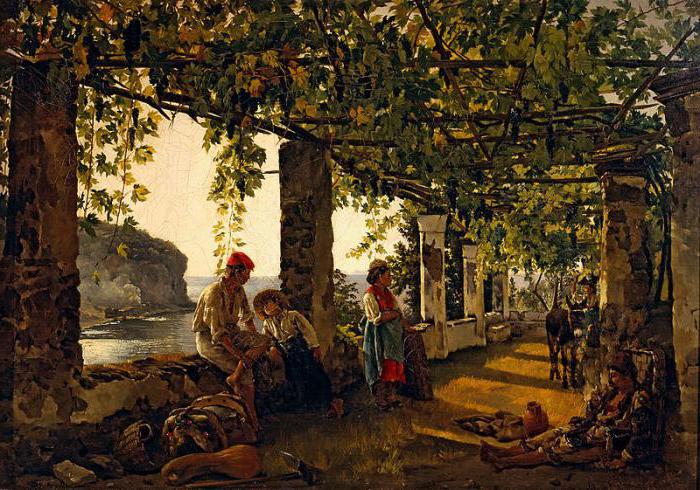Sylvester Shchedrin stood at the origins of the Russian romantic landscape. Despite the fact that his life was short-lived, he left behind many wonderful works. The artist’s most famous cycle is New Rome. Castle of the Holy Angel. " Thanks to the works of Shchedrin, the landscape in Russia reaches a new level and begins to be quoted as an independent genre.
Youth in Russia
On a frosty winter day, Sylvester Shchedrin was born in an old noble family. The artist’s biography is mainly connected with Italy, here he created his best canvases. In Russia, only the youth of the painter passed. Despite the years spent abroad, the artist always felt like a Russian person and was keenly interested in the fate of his homeland. He was born in February 1791 in the family of the rector of the Academy of Arts, Theodosius Fedorovich Shchedrin. Uncle, Semyon Fedorovich, was a professor at the Academy and led his class. Needless to say, with such gifted relatives the fate of the boy was a foregone conclusion.
At 9 years old, Shchedrin became a graduate of the Academy. When the time came to choose a specialization, he was going to enter the class of his uncle, specializing in a sentimental landscape. But Semyon Fedorovich unexpectedly dies, and the young man chooses Professor Mikhail Ivanov as mentor.
1808 brought the student the first, small silver medal for drawing from life. The following year, he was awarded a small gold one for his successes in painting. And in 1812, Shchedrin graduated from the Academy with the award of a large gold medal for the canvas “View from the Petrovsky Island”. Such a reward gave the graduate the right to travel to Italy to get acquainted with the rich nature and masterpieces of classical art, the so-called “retirement”. But because of the war with Napoleon, the trip had to be postponed. Only in 1818, the artist finally managed to leave for Italy. He will not return to Russia anymore.
Italy
At the age of 27, Shchedrin ends up in Rome. Initially, he settled with the poet Konstantin Batyushkov. After the strict cold Petersburg with eternal rains, sunny Italian nature seemed to the artist an earthly paradise. He works exclusively from nature, which for that time was a revolutionary move. The artist does not just write, he enjoys picturesque views of green valleys and the azure sea. He perfectly manages to convey the effects of lighting, atmosphere and air. Sylvester Shchedrin becomes a real singer of Italian nature. The paintings of the artist want to acquire not only Russian, but also sophisticated local collectors.

After Rome, Shchedrin went to Naples. However, revolutionary unrest was brewing there and it was unsafe to remain. The painter again settled in Rome. In 1823 he created his most famous painting - “New Rome. Castle of the Holy Angel. " In the same year, the Academy of Arts retired, it was time to return to their homeland. But the works of Shchedrin were so successful in Italy that he decided to linger here. Once again, the artist moves to Naples. He spends winters in the city, and in the warm time he travels to small coastal cities, making full-scale sketches.
It is not known whether Shchedrin planned to return to Russia. From the correspondence it is clear that the fate of the Motherland and Russian art greatly worried him, although he was in no hurry to leave Italy. One way or another, he was not destined to return. The artist was crippled by a serious illness, from which neither expensive treatment at the resorts nor charlatan drugs helped. Sylvester Feodosievich Shchedrin died at the age of 39, in November 1830.
Creation
The formation of the landscape as such, and romantic in particular, is associated in Russia with the names of Shchedrin and Aivazovsky. Before these masters, the image of nature was considered an elegant salon genre and did not carry much weight. Portraits and historical canvases were preferred. Nature was considered mainly as a backdrop for the placement of a model or military battles. The romantic landscape was preceded by a sentimental, usually depicting pacific pastorals or nostalgic views of country estates. Romanticism humanized nature, now it becomes a protagonist in the picture, expresses the thoughts of the artist. The favorite plot of romantic artists is the sea and mountains. Shchedrin began within the framework of classicism, but quickly moved away from him. Its picturesque sunny valleys and sea views in moonlight are a romantic genre.

Many of the artist’s works never got to Russia, dispersing into private Italian collections. Not all the painter’s heritage is known and considered. In the St. Petersburg Russian Museum you can see "View of Amalfi near Naples", "View of the Coliseum in Rome", "Waterfall in Tivoli near Rome." The Tretyakov Gallery houses Moonlit Night in Naples, Grotto Matromanio, Big Harbor on Capri Island, and Small Harbor in Sorrento. Some works are stored in regional museums, for example, “View of Naples from the Posilippo Road” or “Grotto with a View of Vesuvius”.
Castle of the Holy Angel
“Castle of the Holy Angel” (1823–1825) is Shchedrin's most famous plot. Strictly speaking, this was not a picture, but a whole cycle of eight paintings under the general name. The first work was such a resounding success that, by popular demand, Shchedrin made several more repetitions, varying the illumination and time of day. One of the works is in the Tretyakov Gallery.
On canvas, the artist depicted the Tiber embankment near the house where he lived. Background given to the "old" Rome. Here you can see the castle and the cathedral, lost in the haze of air. In the foreground are old residential buildings, a promenade and fishing boats. The accuracy of the work is given to carefully written figures of poor fishermen. The picture lives and breathes. Shchedrin emphasizes contrasts: on the canvas side by side the magnificent Roman past and not the most formal present.
"Veranda entwined with grapes"
The motif of green arbors and terraces was one of the favorite during Shchedrin's mature work. He himself called it "Pergolate." Pergola in Italian - a porch or alley under the roof, covered with curly greens. In these paintings, the artist experimented with a plausible transmission of light-air space, achieving vividness of the canvas. The most famous painting on this plot is “Veranda, entwined with grapes” (1828). Hot Italian noon. A group of people stopped to relax in the coolness of the terrace. We do not know whether this is a family or random travel companions. It is evident that they are tired of the sweltering heat. People here are not just extras, each figure is expressive and not accidental. They are in unity with nature and complement it, without them the picture would have looked unfinished. The blessed shadow alternates with golden sunny squares, in the background the sea turns blue. Looking at the picture, the viewer himself falls into this hot Italian summer.

Naples on a moonlit night
In the last period of his life, Sylvester Shchedrin was carried away by sea landscapes with dramatic lighting. He wrote several nightly scenes depicting a sea flooded with alarming moonlight. One of them is located in St. Petersburg, this is Naples on a Moonlit Night (1829). The picture can be divided into three parts. To the right is a dark sea with boat silhouettes. To the left are city buildings and a boat pier, where fishermen bask in the fire. The picture is crowned by a romantic sky, covered in clouds, where a night luminary peeps out in the gap between the clouds. On this canvas, the artist solves a difficult problem: combine in one composition the cold moonlight and the warm flame of a blazing bonfire.
Researchers of Shchedrin’s work say that his later works are significantly inferior to earlier sunny landscapes in harmony and integrity.